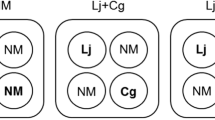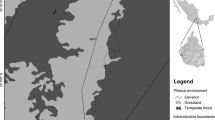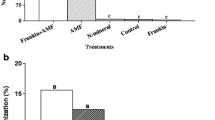Abstract
The survival, development and mycorrhizal efficiency of a selected strain of Laccaria bicolor along with naturally occurring ectomycorrhizal fungi in a young plantation of Douglas fir was examined. Symbionts were identified and their respective colonization abilities were determined. Eight species of symbiotic fungi, which may have originated in adjacent coniferous forests, were observed on the root systems. Mycorrhizal diversity differed between inoculated (5 taxa) and control (8 taxa) seedlings. Ectomycorrhizal fungi which occurred naturally in the nursery on control seedlings (Thelephora terrestris and Suillus sp.) did not survive after outplanting. Both inoculated and naturally occurring Laccaria species, as well as Cenococcum geophilum, survived on the old roots and colonized the newly formed roots, limiting the colonization by other naturally occurring fungi. Other fungi, such as Paxillus involutus, Scleroderma citrinum and Hebeloma sp. preferentially colonized the old roots near the seedling's collar. Russulaceae were found mainly in the middle section of the root system. Mycorrhizal colonization by Laccaria species on inoculated seedlings (54%) was significantly greater than on controls (13%) which were consequently dominated by the native fungi. Significant differences (up to 239%) were found in the growth of inoculated seedlings, especially in root and shoot weight, which developed mainly during the second year after outplanting. Seedling growth varied with the species of mycorrhizae and with the degree of root colonization. Competitiveness and effectiveness of the introduced strain on improving growth performances of seedlings are discussed.
Similar content being viewed by others
References
Al-Abras K 1985 Évolution des types de mycorhizes de l'épicéa commun en fonction de l'âge. DEA mem., Université de Nancy I 55 p.
Al-Abras K, Bilger I, Martin F, LeTacon F and Lapeyrie F 1988 Morphological and physiological changes in ectomycorrhizas of spruce [Picea excelsa (Lam.) Link] associated with ageing. New Phytol. 110, 535–540.
Armstrong J L, Fowles N L and Rygiewicz P T 1989 Restriction fragment length polymorphisms distinguish ectomycorrhizal fungi. Plant and Soil 116, 1–7.
Bledsoe C S and Zasoski R J 1983 Effects of ammonium and nitrate on growth and nitrogen uptake by mycorrhizal Douglas-fir seedlings. Plant and Soil 71, 445–454.
Bledsoe C S, Tennyson K and Lopushinsky W 1982 Survival and growth of outplanted Douglas-fir seedlings inoculated with mycorrhizal fungi. Can. J. For. Res. 12, 720–723.
Chu-Chou M and Grace L J 1981 Mycorrhizal fungi of Pseudotsuga menziesii in the North Island of New Zealand. Soil Biol. Biochem. 13, 247–249.
Danielson R M 1988 Mycorrhizae in forestry: The state of the art in land reclamation. In Canadian Workshop on Mycorrhizae in Forestry, 1–4 May 1988 at Sainte-Foy (Québec) Canada. Eds. MLalonde and YPiché. pp 39–41. Centre de Recherche en Biologie Forestière, Université Laval, Sainte-Foy.
Dighton J and Mason P A 1985 Mycorrhizal dynamics during forest tree development. In Development Biology of Higher Fungi. Eds. DMoore, L ACasselton, D AWood and J CFrankland. pp 117–139. Cambridge University Press, Cambridge.
Frankland J C and Harrison A F 1985 Mycorrhizal infection of Betula pendula and Acer pseudoplatanus: Relationships with seedling growth and soil factors. New Phytol. 101, 133–151.
Garbaye J 1982 Quelques aspects de la competitivité des souches ectomycorhiziennes. In Les Mycorhizes, Partie Intégrante de la Plante: Biologie et Perspectives d'Utilisation. Eds. S Gianinazzi, V Gianinazzi-Pearson and A Trouvelot. pp 303–312. Proceedings of a seminar, 5–6 May 1982 at Dijon, France, les Colloques de l'INRA, no. 13.
Garbaye J 1983 Premiers résultats des recherches sur la compétitivité des champignons ectomycorhiziens. Plant and Soil 71, 303–308.
Garbaye J and Wilhelm M E 1984 Influence de la mycorhization acquise en pépinière sur la mycorhization de jeunes plantation de chêne. Ecol. Plant. 5, 151–161.
Grossnickle S C and Reid C P P 1982 The use of ectomycorrhizal conifer seedlings in the revegetation of a high-elevation mine site. Can. J. For. Res. 12, 354–361.
Grossnickle S C and Reid C P P 1983 Ectomycorrhiza formation and root development patterns of conifer seedlings on a high-elevation mine site. Can. J. For. Res. 13, 1145–1158.
Hall I R and Garden E 1985 Effect of fertilizers and ectomycorrhizal inoculum on stunted Douglas-firs. In Proceedings of the 6th NACOM, 25–29 June 1984 at Bend, Oregon, USA. Eds, RMolina. p. 224. Forest Research Laboratory, Oregon State University, Corvallis.
Harvey A E, Larsen M J and Jurgensen M F 1979 Comparative distribution of ectomycorrhizae in soils of three western Montana forest habitat types. For. Sci. 25, 350–358.
Harvey A E, Jurgensen M F, Larsen M J and Graham R T 1987 Relationships among soil microsite, ectomycorrhizae and natural conifer regeneration of old-growth forests in western Montana. Can. J. For. Res. 17, 58–62.
Hung L L and Molina R 1985 Nursery inoculation of Douglas-fir seedlings with commercially produced ectomycorrhizal inoculum. In Proceedings of the 6th NACOM, 25–29 June 1984 at Bend, Oregon, USA. Eds. RMolina. p 209. Forest Research Laboratory, Oregon State University, Corvallis.
Kropp B R 1982 Formation of mycorrhizae on nonmycorrhizal western hemlock outplanted on rotten wood and mineral soil. For. Sci. 28, 706–710.
Kropp B R and Langlois C G 1990 Ectomycorrhizae in reforestation. Can. J. For. Res. 20, 438–451.
Le Tacon F 1982 Perspectives de la maîtrise de la mycorhization en sylviculture. In Les Mycorhizes, Partie Intégrante de la Plante: Biologie et Perspectives d'Utilisation. Eds. S Gianinazzi, V Gianinazzi-Pearson and A Trouvelot. pp 273–285. Proceedings of a seminar, 5–6 May 1982 at Dijon, France, les Colloques de l'INRA, no. 13.
LeTacon F and Bouchard D 1986 Effects of different ectomycorrhizal fungi on growth of larch, Douglas-fir, Scots pine and Norway spruce seedlings in fumigated nursery soil. Ecol. Appl. 7, 389–402.
LeTacon F, Jung G, Michelot P and Mugnier M 1983. Efficacité en pépinière forestière d'un inoculum de champignon ectomycorhizien produit en fermenteur et inclus dans une matrice de polymères. Ann. Sci. For. 40, 165–176.
LeTacon F, Lamoure D, Guimberteau J and Fiket C 1984 Les symbiotes mycorhiziens de l'épicéa commun et du Douglas dans le Limousin. Rev. For. Française 4, 325–338.
Marks G C and Foster R C 1967 Succession of mycorrhizal associations on individual roots of radiata pine. Aust. Forest. 31, 193–201.
Marx D H 1977 The role of mycorrhizae in forest production. TAPPI Conf. Ann. Meeting, Atlanta (Ga), pp 151–161.
Marx D H 1980 Ectomycorrhizal fungus inoculation: A tool for improving forestation practice. In Tropical Mycorrhiza Research. Ed. PMikola. pp 13–71. Clarendon Press, Oxford.
Marx D H and Cordell C E 1988 Specific ectomycorrhizae improve reforestation and reclamation in the eastern United States. In Canadian Workshop on Mycorrhizae in Forestry, 1–4 May 1988 at Sainte-Foy (Québec) Canada. Eds. MLalonde and YPiché. pp 75–86. Centre de Recherche en Biologie Forestière, Université Laval, Sainte-Foy.
McAfee B J and Fortin J A 1986 Competitive interactions of ectomycorrhizal mycobionts under field conditions. Can. J. Bot. 64, 848–852.
McAfee B J and Fortin J A 1989 Ectomycorrhizal colonization on black spruce and jack pine seedlings outplanted in reforestation sites. Plant and Soil 116, 9–17.
McComb A L and Griffith J E 1946 Growth stimulation and phosphorus absorption of mycorrhizal and nonmycorrhizal northern white pine and Douglas-fir seedlings in relation to fertilizer treatment. Plant Physiol. 21, 11–17.
Mikola P 1973 Mycorrhizal symbiosis in forestry practice. In Ectomycorrhizae, their Ecology and Physiology. Eds. G CMarks and T TKozlowski. pp 348–411. Academic Press, New York/London.
Molina R 1980 Ectomycorrhizal inoculation of containerized western conifer seedlings. USDA For. Serv. Res. Note PNW-357. 10 p.
Molina R 1982 Use of the ectomycorrhizal fungus Laccaria laccata in forestry. I. Consistency between isolates in effective colonization of containerized conifer seedlings. Can. J. For. Res. 12, 469–473.
Molina R and Chamard J 1983 Use of the ectomycorrhizal fungus Laccaria laccata in forestry. II. Effects of fertilizer forms and levels on ectomycorrhizal development and growth of container-grown Douglas-fir and ponderosa pine seedlings. Can. J. For. Res. 13, 89–95.
Morgan P 1985 Pacific northwest forest nursery mycorrhizae research: Boon or boondoggle? In Proceedings of the 6th NACOM, 25–29 June 1984 at Bend, Oregon, USA. Ed. RMolina. pp 73–74. Forest Research Laboratory, Oregon State University, Corvallis.
Pachlewski R and Pachlewska J 1974 Studies on symbiotic properties of mycorrhizal fungi of pine (Pinus sylvestris L.) with the aid of the method of mycorrhizal synthesis in pure cultures on agar. For. Res. Inst., Warsaw, Poland.
Parke J L, Linderman R G and Black C H 1983a The role of ectomycorrhizas in drought tolerance of Douglas-fir seedlings. New Phytol. 95, 83–95.
Parke J L, Linderman R G and Trappe J M 1983b Effects of forest litter on ectomycorrhiza development and growth of Douglas-fir and western red cedar seedlings. Can. J. For. Res. 13, 666–671.
Sinclair W A 1971 Additive effects of different types of ectomycorrhizae on growth of Douglas-fir seedlings. Phytopathology, 61, 911.
Sinclair W A 1974 Development of ectomycorrhizae in a Douglas-fir nursery. I. Seasonal characteristics. For. Sci. 20, 51–56.
Sinclair W A, Sylvia D M and Larsen A O 1982 Disease suppression and growth promotion in Douglas-fir seedlings by the ectomycorrhizal fungus Laccaria laccata. For. Sci. 28, 191–201.
Trappe J M 1977 Selection of fungi for ectomycorrhizal inoculation in nurseries. Annu. Rev. Phytopathol. 15, 203–222.
Trappe J M and Strand R F 1969 Mycorrhizal deficiency in a Douglas-fir region nursery. For. Sci. 15, 381–389.
Author information
Authors and Affiliations
Rights and permissions
About this article
Cite this article
Villeneuve, N., Le Tacon, F. & Bouchard, D. Survival of inoculated Laccaria bicolor in competition with native ectomycorrhizal fungi and effects on the growth of outplanted Douglasfir seedlings. Plant Soil 135, 95–107 (1991). https://doi.org/10.1007/BF00014782
Received:
Issue Date:
DOI: https://doi.org/10.1007/BF00014782




